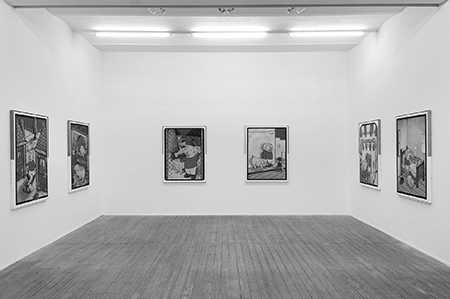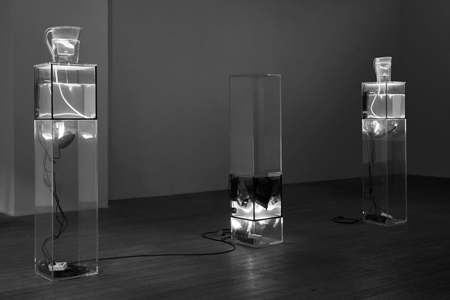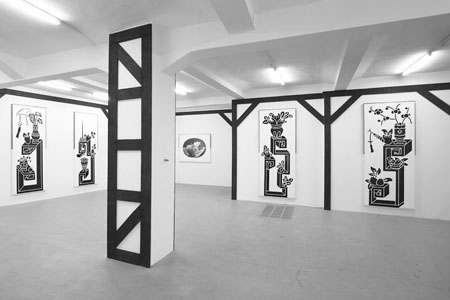
Nuri Koerfer, Richard Frater, Thomas Jeppe, Gina Fischli, Camille Blatrix Inversion II
8. September - 28. October 2023
exhibition views
“Haute Tension”
A functional bench with dog heads, a bookshelf/bear, an armchair perforated by worms; a group of frozen metamorphoses bridging the worlds of animals and furniture. (NK)
Three photographs of Kea - the New Zealand native parrot considered the world’s smartest bird - vandalising tourist cars in a nature reserve. (RF)
An orange tree juicing itself, another chopping firewood; one laying a log as a bridge, another varnishing a pine handrail; various acts of self-exploitation in the service of others. (TJ)
A cat, a rat, a platypus, a bird, handmade in wire, plaster, textile strips and costume jewellery gemstones; a collected projection of human detritus into animal representation, and a mouse behind bars at grand scale. (GF)
An apple held by a disembodied hand, carved in wood and abstracted into geometric harmony. (CB)
Inversion 2: Haute Tension is the sequel to Umwelt Inversion (2016). *
* Umwelt Inversion (2016 at Galerie Conradi, with Marina Pinsky, Richard Frater, Martine Syms, James Vinciguerra, Thomas Jeppe, Anna Franceschini, and Alejandro Almanza Pereda) dealt with forms of social, formal, biological, semantic, corporeal and architectural inversion - combining to form an ‘umwelt’ overview of morphing oppositions.
With Inversion 2, the thematic scope has narrowed, allowing more focus, becoming more baroque. Here we face an inversion of a perceived order in the relationship between ‘humanity’ and the ‘natural world’. This ‘natural world’ comprises collected elements of a living mechanism, alternatively liberated through violence, paralysed into decorative purpose, or cursed by a self-cannibalising generosity. The ‘humanity’ by contrast is most notable in its absence.
“Haute Tension” - high tension, high voltage. There is an energy at this intersection of human expectation and the reality of nature, an affective misalignment in a continuous process of recalibration. The friction of incompatibilities that demands an outlet.
Lattice: a porous rigid barrier for controlling the development of plants in space, for enforcing order.
**There is an additional subtext to Inversion 2, one quite removed from content and nestled more in the field of socio-professional logistics. Of the five artists involved, four are parents, with seven children between them. The existence (and proliferation) of family structures, with their attendant responsibilities, emergencies, and inevitabilities, edges us towards the animal world - an instinct-driven modus operandi where all non-essential activities are eclipsed by the deluge of daily imperatives. With this in mind, it’s a minor miracle that the show managed to happen at all, and a testament to the professionalism of all involved.
organised by
Thomas Jeppe**

Thomas Jeppe, Neuer wall.
28. June - 4. September 2021
exhibition views
supported by Stiftung Kunstfonds
![]()
![]()
The Mask is a series of 12 paintings of a pig wearing the mask of a pig. Going into public disguised as himself, the masked pig experiences daily life in a state of “reinforced self-projection.”
Beyond his urban surrounds, the masked pig meets a real pig, which breaks his understanding of natural order and raises big questions about authenticity. The real pig and the masked pig return to the city to sleep together. They share a space of dreaming, but their relationship remains ambivalent.

Thomas Jeppe, Umwelt Inversion
9. September - 15. October 2016
exhibition views
Umwelt Inversion brings together a group of works from Marina Pinsky, Anna Franceschini, Thomas Jeppe, Alejandro Almanza Pereda, Martine Syms, Richard Frater, and James Vinciguerra. In the frame of the switched, the reconfigured and the re-inscribed, these works are inversions of environmental elements which form in turn an inverted environment. This exhibition is the (inverted) spiritual sequel to the Unsere Umwelt gallery project held in a hole in the ground in Basel in June 2016.
1.
Inversion is a process of transition between incompatibilities; conditions which cannot exist alongside one another. The overcoming of their counterpart state is a necessary step to be and to flourish.
Inversion implies a structural reconfiguration, for the object cannot change while continuing to obey the dictates of the thing which it was ceased to be.
2.
The thing inverted has an ambivalent relationship to the idea of negotiation.When the thing is mercurial, floating and un-fixed, it knows diplomacy. At the point of inversion, it becomes unequivocal. This is the crossing of the threshold. For reasons peculiar to the case, the former state can no longer be tolerated and must be surpassed.
3.
What appeals to the imagination is not the moment of inversion, but its vocabulary, both in the midst – and the aftermath – of transition.
And this transition, its incremental stages floating between the concrete ends of a spectrum, appears so uncanny because its working materials are 'the familiar'. The thing that is 'known' in one state only; a process at the knowledge of which the conservative feather cannot help but be ruffled.
4.
But the thing does not change entirely. To be 'one thing' – then to undergo a shift – is not to obliterate an objective history but to embellish it.
To even be capable of such transformation – an initial malleability giving way to so emphatic a transition – inversion is an expression of 'stamina'.
In this stamina, the momentum of 'new order' meets with the thrill of variation; the thing's inverted aspects, aligned with perennial qualities of the former state, a certain sign of a dynamism entrenched.
5.
The 'flip' is a ponderous concept, lavished in the sentiment of reflection.
Inversion does not simply mirror a situation; it produces it. In a decimating account of the thing's facets, it describes them and makes them concrete in the singular fell swoop of an opposite proffered.
The apparent opposite, trusted as definition, serves only to outline the complexity of endless oppositeness embodied. Rather than to each object its own certain inverse, there exist multiple possible inversions, any number of semantic realignments that serve to sever a moored being thought stable.
In the face of this inverted multiplicity, a binary conception dissolves in the realm of hyperbolic alternative. The 'mirror stage' of the knowing self becomes thus evanescent: no certain other emerges from the mottled view of crude reflections dormant at the glass.
6.
To embody a difference anew is to crystallize a latency. This latency is a testament to an in-built fragmentation, one of myriad exclusivities; the inverted thing did always have a fractured unity.
The thing shifts in obedience to an obscure but irresistible impulse – the desire to know an altered state. But the certainty of the shift – the process a categorical re-inscription – 'bathes' the thing in a new lucidity.
7.
As lucidity is next to luminosity, obscurity is next to the shadow; cast by the clarity of the thing inverted.
The true form of inversion presents a paradox of untold reach: to grasp inversion is to know perpetual shadows, ladies-in-waiting with each that fragrance no artifice can impart.
Burning in this diaphanous field, the original is reduced to ashes, but these ashes are not cast from memory.
8.
Neutrality is a vacuum, an abyss; inversion is its definitive refute.
The analysis of inversion requires venturing towards contradiction to obtain the confirmation of a fact, the thought of which enchants me.
9.
Inversion is, at its political peaks, testament to a coexistence. These ruminations on the topic, the 'barren' frivolity of which we forget for the windfall of a single revelation, are devised to elaborate on some lingering uncertainties around the mechanics of inversion.
They are shared in the hope that there will soon be no illusion left to shatter.
Text: Thomas Jeppe
DE
Thomas Jeppe bringt in der Ausstellung Umwelt Inversion verschiedene Arbeiten von Marina Pinsky, Anna Franceschini, Martine Syms, Alejandro Almanza Pereda, Richard Frater und James Vinciguerra zusammen. Grundprinzip der Ausstellung ist das der Umkehrung –Perspektivwechsel, Verschiebung und Neu-Einschreibung. Die ausgestellten Videoarbeiten, Skulpturen und Objekte implizieren bereits formale und inhaltliche Inversionen, im Zusammenhang der Ausstellung werden sie selbst zu Elementen eines Environments das in sich ein komplexes Bezugssystem aus inversiven Ebenen behauptet. Diese Ausstellung ist die (umgekehrte) gedankliche Fortführung des Galerie-Projektes Unsere Umwelt das im Sommer 2016 in einer Baugrube in Basel stattgefunden hat.

Thomas Jeppe, Lost In Connotation
7. September - 25. October 2014
exhibition views
Lost in Connotation is the title of Thomas Jeppe’s second solo show at Galerie Conradi. An expansive structure painted sky-blue, the open architecture of the pergola (Social Sculpture 1, 2) defines an organization of the exhibition space that is echoed by the sculptures and pictures as an arrangement of corresponding elements. Face to face with the paintings, an architectural intervention in the gallery space and specific local reference (The Bench) points to a social praxis in the urban context the artist himself engages in. The Bench is the show’s thematic pivot, as the essay published in conjunction with the opening explains:
One of our basic community practices is Benching, a ritual of critical disengagement in a fixed civic ambiance. Benching involves playful-deconstructive behaviour and awareness of psychosociological situations, and is thus quite different from the classic notions of relaxation and recuperation. (...) from a Benching point of view cities have psychosociological contours, with constant currents, fixed points and vortexes that strongly encourage stopping at certain zones. But Benching includes both this letting-go and its necessary contradiction: the domination of psychosociological variations by the knowledge and calculation of their possibilities. In this latter regard, social theatre, despite the narrow public space to which it limits itself, provides abundant evocative data. The ecological analysis of the absolute or relative character of fissures in the urban network, of the role of microclimates, of distinct neighbourhoods with no relation to administrative boundaries, and above all of the dominating action of centres of attraction, must be utilised and completed by this psychosociological method. The objective passional terrain of the Bench must be defined in accordance both with its own logic and with its relations with social morphology.
(Manuel Bürger & Thomas Jeppe, Theory of the Bench, 2014)
* (Théorie de la Dérive, Guy Debord, In: Internationale Situationniste #2, Paris, December 1958).
The essay, an appropriation of Guy Debord’s 1958 text, draws connections between concepts developed by the Situationist International and the reconquest of public spaces practiced by the artist and his circle. An anarchist publication from 1970s Zurich provides a visual motif that is central to the exhibition: the globe as a blind man walking with a stick—isolated from its original context and transplanted, as an allegorical figure, into the referential system of the show, the forward-looking world comes to illustrate a critique of cultural production: Lost in Connotation. The public space as a site of social interaction (The Bench) and The Club as a paradigmatic scene of heightened mental and physical awareness and experience mark the points of departure for larger questions of cultural theory. The painting of the Darkroom pictures is so austere and classical as to verge on the theatrical; the architectural elements in the show, meanwhile, invite active participation.
DE
Lost in Connotation ist der Titel der zweiten Einzelausstellung von Thomas Jeppe in der Galerie Conradi. Raumgreifend und in Himmelblau gestrichen, gibt die offene Architektur der Pergola (Soziale Skulptur 1, 2) eine Strukturierung des Ausstellungsraumes vor, die von den Skulpturen und Bildern als eine Anordnung korrespondierender Elemente aufgenommen wird. Der Malerei gegenübergestellt verweist ein baulicher Eingriff im Galerieraum als spezifischer lokaler Bezug (The Bench) auf eine persönliche soziale Praxis des Künstlers im urbanen Kontext. The Bench ist inhaltlicher Drehpunkt der Ausstellung und wird in dem zur Eröffnung erscheinenden Essay erläutert:
One of our basic community practices is Benching, a ritual of critical disengagement in a fixed civic ambiance. Benching involves playful-deconstructive behaviour and awareness of psychosociological situations, and is thus quite different from the classic notions of relaxation and recuperation.
(...) from a Benching point of view cities have psychosociological contours, with constant currents, fixed points and vortexes that strongly encourage stopping at certain zones. But Benching includes both this letting-go and its necessary contradiction: the domination of psychosociological variations by the knowledge and calculation of their possibilities. In this latter regard, social theatre, despite the narrow public space to which it limits itself, provides abundant evocative data. The ecological analysis of the absolute or relative character of fissures in the urban network, of the role of micro-climates, of distinct neighbourhoods with no relation to administrative boundaries, and above all of the dominating action of centres of attraction, must be utilised and completed by this psychosociological method. The objective passional terrain of the Bench must be defined in accordance both with its own logic and with its relations with social morphology.
(Manuel Bürger & Thomas Jeppe, Theory of the Bench, 2014)
* (Théorie de la Dérive, Guy Debord, In: Internationale Situationniste #2, Paris, December 1958).
Der Essay, eine Aneignung des Textes von Guy Debord von 1958, stellt Konzepte der Situationistischen Internationale in den Zusammenhang mit der vom Künstler und seinem Umfeld praktizierten Rückeroberung des öffentlichen Raums. Eine anarchistische Publikation aus dem Zürich der siebziger Jahre liefert ein für die Ausstellung zentrales Bildmotiv: die Weltkugel am Stock, als blinder Mann – aus ihrem ursprünglichen Kontext gelöst und als allegorische Figur in das Referenzsystem der Ausstellung übertragen, wird die vorwärtsgewandte Welt zur Illustration einer Kritik der Kulturproduktion: Lost in Connotation. Der öffentliche Raum als Ort sozialer Interaktion (The Bench) und der Club (The Club) als beispielhafter, mentaler und physischer Erlebnis- und Erfahrungsraum bilden die Ausgangspunkte für übergeordnete kulturtheoretische Fragestellungen. Während die Malerei der Darkroom-Bilder durch Reduktion und Klassik bis ins Theatralische getrieben wird, bieten die Architekturelemente der Ausstellung eine aktive Teilnahme an.

Thomas Jeppe, Asiatische Adlernase
7. September - 6. October 2012
exhibition views
Thomas Jeppe is a painter and sculptor with a background in publishing and cultural studies. His practice engages aspects of cultural production and transition, where strategies of appropriation develop into
semantic reconstruction. Through traditional portraiture, laborious formal abstraction paintings and highly-finished sculpture, Jeppe’s works become props; critical tools pointing to cultural fissures while underscoring their own nature as theatrical constructions in a secondary role to ‘the bigger story’.
Asiatische Adlernase began with an interview made in 2010 with a German gallerist who left the art world in search of a prestigious cultural form with a foundation of objective reasoning. He found this in Taiwanese tea, and subsequent attempts to introduce this practice to Germany were confounded by a broad range of cultural structures - primarily stemming from the clichéd divide, East and West. Informed by the themes of master
culture, vernacular rituals, anti-globalism and the difficulties of cultural transposition, Jeppe travelled to Taiwan in 2012 to conduct his own research on tea and its surrounding context. The exhibition features six large-scale paintings based on a lamp from the reading room of a Nineteenth Century Taipei mansion. Though simple in
form, the series cannot be readily classified, presenting an uneasy combination of false geometry and unidentifiable fruits and vessels. Monochrome in thick gloss enamel, with artist-made two-tone frames, these paintings become an analogy for cultural incommensurability. An earnest re-creation of Jean Honoré-Fragonard‘s Der Philosoph oversees the analogy; a laborious enlargement of a proto-Impressionist anomaly of
the Rococo era, a stand-in for emphatically Western tradition, knowledge, and anachronism. Together, these pictures are housed within a Fachwerk architectural installation, an icon of early-Renaissance European houses,
making visible the ordinarily hidden frameworks of construction.
Thomas Jeppe lived in Hamburg in 2010 with a grant from Fleetinsel Gastatelier, when he also made the show The Peoples Poet: Prevention of Education Through Poetry with Thomas Baldischwyler at Conradi.
DE
Ausgangspunkt für die Ausstellung Asiatische Adlernase war ein Interview das der Künstler und Herausgeber des Melbourner WON Magazins, Thomas Jeppe, 2010 mit einem ehemaligen deutschen Galeristen geführt hatte. Dessen Abkehr von der Kunstwelt und die Suche nach einer auf objektiven Kriterien der Qualität basierenden Ausdrucksform von Kultur hatte ihn zu einer langjährigen Ausbildung über Teekultur, nach Taiwan geführt. Thomas Jeppe interessierte sich besonders für den gescheiterten Versuch, diese Kultur nach Deutschland zu bringen und ein Geschäftsmodell dafür zu etablieren. Die damit verbundenen Fragen nach unüberwindbaren kulturellen Differenzen und Globalisierung regten den Künstler schließlich zu einer Reise nach Taiwan an. Hier entdeckte er in Taipeh, in einem historischen Teehaus aus dem 19. Jahrhundert, eine Lampe deren Bildfelder er als Vorlage für die sechs hohen und schmalen Bildtafeln in seiner Einzelausstellung in Hamburg verwendete.
Durch die stark vergrößerte Übertragung der Darstellungen auf 2.5 Meter hohe Leinwände treten die Stilisierung der Gegenstände und Früchte und die perspektivischen Fehler der ornamentalen Elemente deutlich hervor. Ebenso rätselhaft wie die Ästhetik der Bildvorlagen erscheint ihre Übersetzung in hochglänzende Lackbilder und deren Transfer in einen Ausstellungsraum, der durch Renaissance - typische Fachwerk Applikationen strukturiert und rhythmisiert wurde. Kulturelle Deplatziertheit löst Befremden und Missverständnisse aus, und alles läuft zusammen in der mürrischen, oder entsetzten, Miene des ‚Philosophen’ nach Jean Honoré Fragonard. Diese detailgetreue Nachbildung eines Gemäldes aus der Sammlung der Hamburger Kunsthalle, ein stilistisch nicht repräsentatives Rokoko Portrait, wird in diesem heterogenen Ausstellungszusammenhang zum Stellvertreter für Anachronismus, zum Repräsentanten westlicher Bildtradition und Kulturgeschichte. Die Malerei, die künstlerische Praxis, wird zum Werkzeug für eine Kulturkritik, sie zeigt Brüche im Transfer auf, und legt in der Überästhetisierung dabei gleichzeitig ihre eigene Beschaffenheit als Konstruktion und Detailaspekt eines übergeordneten Zusammenhangs offen.